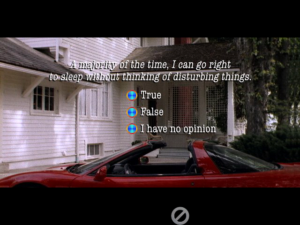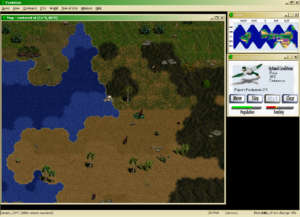Posting very late today. Playing the Cenozoic scenario turned out to be an even worse morale-wrecker than attempting a full game. Because life is already pretty well advanced, it isn’t long before the opponents start developing the immediate precursors to potentially intelligent life, such as elephants and parrots and australopitheci, all while I’m still struggling to get out of the small-ratlike-creature phase. Seriously, I need to figure out how they’re managing it. The one trick I’ve figured out so far is to send my newly-spawned creatures out to colonize new territory as soon as they’re fit for the journey, thereby lessening the demands on the land and increasing the rate at which the population increases.
To explain this in more detail: Each “creature” visible on the map actually represents a herd or colony or something — at any rate, a local population. This was not clear to me in my very first struggles with the game; I had to read the manual to really understand it. When you click on a creature, you get a little pop-up window with details on that creature, including a green bar labeled “Population”. I think that when I first saw this I assumed it referred to the worldwide population of that species, but no, it’s the population of that particular “creature”. It essentially functions like hit points for the group. It fills or empties according to how well the creature is feeding; if it fills completely, the creature splits in two. So in this way, the game is more like a simulation of unicellular life than of tetrapods.
Having lots of creatures of a particular species isn’t good simply because it gives them a better chance of surviving. Each living creature also contributes to the rate at which its species accumulates “evolution points”, which is to say, research into development. Evolution points are automatically spent on three things, in proportions you can set on a per-species basis: improving feeding (and thus population growth), improving combat ability (against another species which you specify — predators use this to predate better, prey species to resist predation), and developing a new species (which you specify). It’s a lot easier to evolve a species that’s populous and well-fed, which seems a little iffy to me — doesn’t natural selection play a more prominent role in situations marked by desperate competition to avoid starvation? But I suppose we have to make some concessions to gameplay. The rule for strategy games is that success is rewarded with more success.
At the very beginning, it obviously makes sense to devote most or all of your evolution points to feeding. But there seems to be a point of diminishing returns there — the detailed species information has another of those green bars indicating how close to its maximum feeding-efficiency potential it is, and this bar seems to only asymptotically approach filling up completely. At some point, it makes sense to devote more and more points to speciation. I suspect that part of my problem is that I haven’t yet discovered the sweet spots for this transition. Do it too late, and the opponents will get the new species before you. Do it too soon and it cuts into the feeding points that would be otherwise growing your population and increasing your evolution point income, with the end result that, again, the opponents beat you to the new species.
You may be thinking “So what, so the opponents beat you out to a few early species. If you have the largest population, you’ll catch up.” Just one problem: When an opponent beats you to a species, it cuts you off. Each species can belong to only one clade at a time. Like the Wonders in Civilization, if someone else beats you to a species you’re in the middle of developing, the points you sank into it just go to waste. In one session, the opponents actually claimed all possible developments from one of my species, leaving it unable to develop further until one of said species went extinct and became up for grabs again.
You may wonder how it’s possible to compete at all in a situation like this, given that speciation is like a branching tree. Claim any common ancestor of all mammals, and you prevent anyone else from developing any mammals at all, right? The game has a way around this, and it’s one of the weirdest things about it in its implications: evolution in the game is what the manual calls “polyphyletic”, which is to say, any given species can evolve through multiple possible routes. Most major branches of the tree of life start out as bundles of about five or six possible common ancestors; not at all coincidentally, six is the maximum number of players. The options from these junctions aren’t entirely equivalent — for example, any of the early mammals can be developed into Miacis and and thence into the entire order of Carnivora, but only one, the Alphadon, can also give you thylacines.
But are thylacines worth it? From the point of view of someone pursuing intelligence, they’re something of a dead end — but then, so is the entire order of Carnivora. But there are strategic reasons to pursue as much diversity as you can: the increased ability to withstand global disasters, the ability to colonize more types of terrain and deny your opponents their exclusive use, even just the points it gives you at the end of the game. Moreover, thylacines and carnivores are predators, and thus have the ability to attack opponents’ creatures — something that you tend not to get on the routes to intelligence. (Saurosapiens notwithstanding — they’re descended from velociraptors.)
But that’s all quite theoretical to me at the moment. Anything I say about advanced strategy is just a repetition of what it says in the beautiful, rigorous, and oft-consulted manual.
 Comments(0)
Comments(0)
